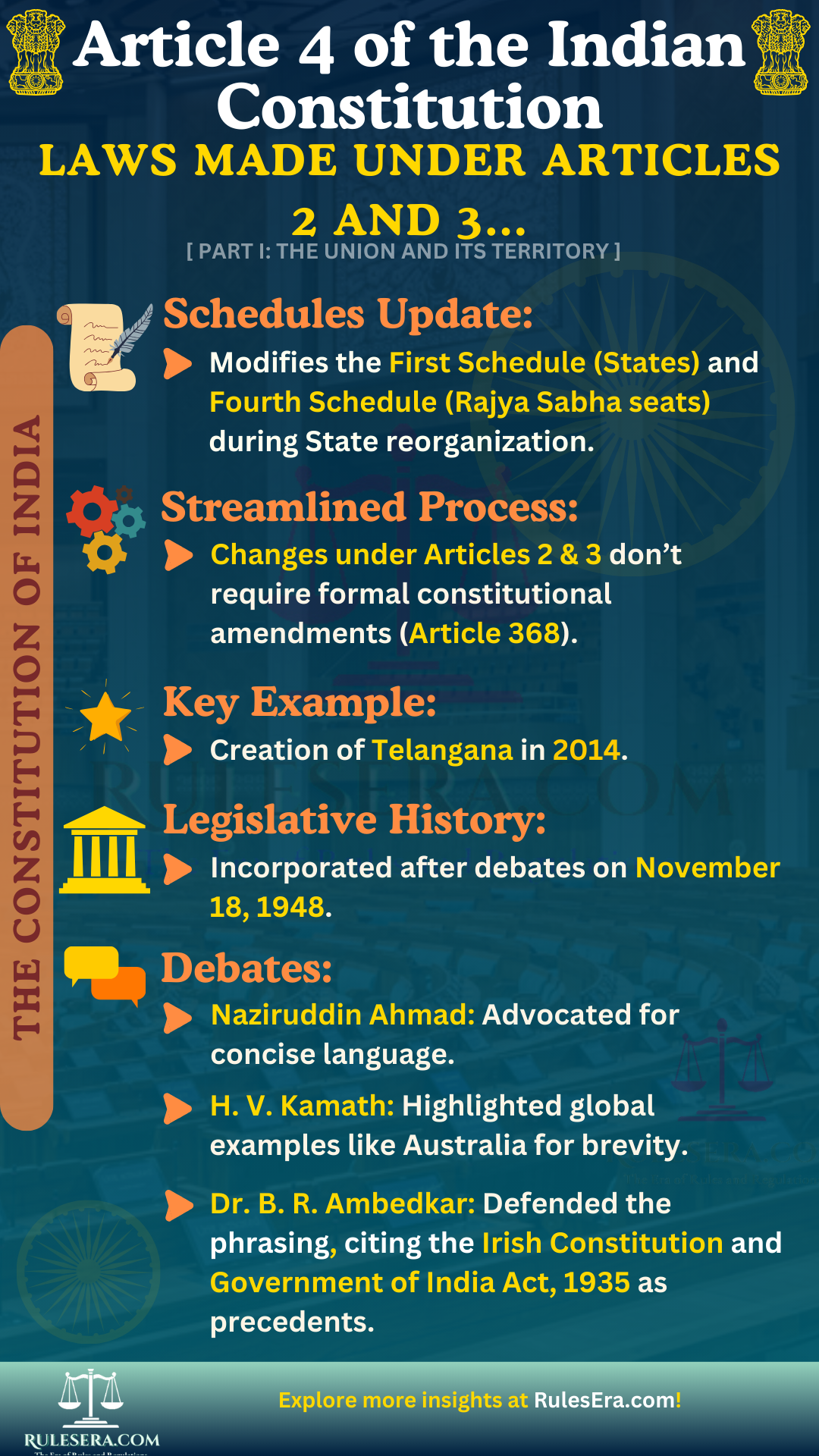Article 4. Laws made under Articles 2 and 3 to provide for the amendment of the First and the Fourth Schedules and related matters

Introduction:
The Indian Constitution grants Parliament extensive powers to reorganize the territories of the country. Articles 2 and 3 allow Parliament to create new States or alter existing ones. However, these changes often require adjustments to other parts of the Constitution, particularly the schedules that deal with State representation and territory. Article 4 outlines how such laws must address these issues while specifying that these changes are not to be treated as formal amendments to the Constitution under Article 368.
Clause (1): Amendments to the First and Fourth Schedules and Related Matters
When Parliament enacts laws under Articles 2 or 3 to create new States or change the boundaries or names of existing ones, these laws must also include provisions for amending two key parts of the Constitution:
- The First Schedule: Lists the States and Union Territories of India. Any law altering State boundaries must update this list accordingly.
- The Fourth Schedule: Allocates seats to each State in the Rajya Sabha (Council of States). When a State’s boundaries or population change, its representation in the Rajya Sabha may need to be adjusted.
In addition to these mandatory amendments, Parliament may also include supplemental provisions related to the administration, governance, or legislative representation of the affected States. These provisions ensure a smooth transition and reflect the changes in the functioning of the Union and State governments.
Clause (2): Exclusion from the Definition of a Constitutional Amendment
Laws made under Articles 2 or 3 are explicitly excluded from being considered constitutional amendments under Article 368. Article 368 prescribes the formal process for amending the Constitution, which typically requires a special procedure and a higher level of legislative consensus. However, Article 4(2) clarifies that the changes required under Articles 2 or 3, even if they involve amending schedules of the Constitution, can be made through regular legislative processes. This makes it easier and faster to implement changes to State boundaries without triggering the more complex constitutional amendment process.
Legislative History:
After thorough deliberations in the Constituent Assembly on November 18, 1948, Article 4 was ultimately incorporated into the Constitution of India.
Debates and Deliberations:
During the discussion on Article 4, Mr. Naziruddin Ahmad proposed several amendments, focusing on simplifying the language by omitting redundant phrases. He referenced similar instances in other legislative contexts, such as the General Clauses Act and the Government of India Act, 1935. Ultimately, Dr. B. R. Ambedkar supported the existing phrasing, explaining its foundation in constitutional precedents from countries like Ireland.
Frequently Asked Questions (FAQs):
Article 4 outlines how laws under Articles 2 and 3 can amend the First and Fourth Schedules and include provisions for governance and representation changes as needed.
Changes to State boundaries or names must update the First Schedule, which lists States and Union Territories, and the Fourth Schedule, which allocates seats in the Rajya Sabha.
No, Article 4 clarifies that such laws are not considered amendments under Article 368 and thus follow regular legislative processes.
He argued for removing redundant phrases for clarity and conciseness, citing precedents from other constitutions. Dr. Ambedkar upheld the existing language based on constitutional traditions.